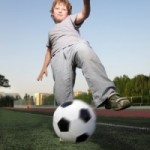Keep your children safe while they’re having fun
 Children love playgrounds, bounce houses and bicycles. But they all can lead to serious injury. Here are some ways you can keep your children safe:
Children love playgrounds, bounce houses and bicycles. But they all can lead to serious injury. Here are some ways you can keep your children safe:
Playgrounds. Each year, more than 500,000 children nationwide are injured on playgrounds badly enough to require a trip to the ER, according to the National Program for Playground Safety. As a general rule, a preschool age child shouldn’t be more than four feet off the ground. Make sure surfaces are cushioned and equipment is maintained.
Bounce houses. Every 45 minutes, a child is rushed to an emergency room due to injuries from an inflatable house, or ‘bounce house.’ Think twice about letting a small child inside a crowded inflatable play area. Injuries often stem from children colliding while jumping.
Bicycles, skateboards and scooters. If you’re riding anything at all with wheels, you and your children should always wear a helmet. Period. Accidents on bicycles, skateboards, scooters and while skating can cause a wide array of injuries, including catastrophic brain injuries.
Bicycle helmets should fit snugly and be level across a child’s forehead. Children under the age of 10 shouldn’t be allowed to drive in the street. Once they are old enough to safely ride in the street, they should wear brightly colored clothing, ride only during the day and follow safety rules, such as riding single file the same direction as traffic and using hand signals when changing directions. Also: Before entering traffic, children should always stop and look left, right and then left again and over their shoulder before proceeding.
And don’t forget: Dehydration and heat exhaustion are risks in the summer, but children under the age of 4 are especially vulnerable to high temperatures. Symptoms of dehydration and heat exhaustion include pale skin, dizziness, headache, fatigue, nausea, and vomiting. Everyone should step up their intake of fluids — preferably water — during the summer months.








